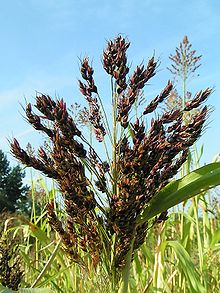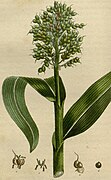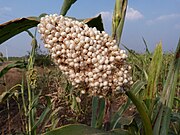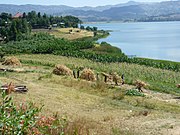
A | B | C | D | E | F | G | H | CH | I | J | K | L | M | N | O | P | Q | R | S | T | U | V | W | X | Y | Z | 0 | 1 | 2 | 3 | 4 | 5 | 6 | 7 | 8 | 9
| Sorghum | |
|---|---|

| |
| Scientific classification | |
| Kingdom: | Plantae |
| Clade: | Tracheophytes |
| Clade: | Angiosperms |
| Clade: | Monocots |
| Clade: | Commelinids |
| Order: | Poales |
| Family: | Poaceae |
| Subfamily: | Panicoideae |
| Genus: | Sorghum |
| Species: | S. bicolor
|
| Binomial name | |
| Sorghum bicolor | |
| Synonyms[1] | |
|
List
| |
Sorghum bicolor, commonly called sorghum[2] (/ˈsɔːrɡəm/) and also known as great millet,[3] broomcorn,[4] guinea corn,[5] durra,[6] imphee,[7] jowar,[8] or milo,[9] is a species in the grass genus Sorghum cultivated for its grain. The grain is used for food for humans; the plant is used for animal feed and ethanol production. Sorghum originated in Africa, and is now cultivated widely in tropical and subtropical regions.
Sorghum is the world's fifth-most important cereal crop after rice, wheat, maize, and barley. Sorghum is typically an annual, but some cultivars are perennial. It grows in clumps that may reach over 4 metres (13 ft) high. The grain is small, 2 to 4 millimetres (0.079 to 0.157 in) in diameter. Sweet sorghums are cultivars primarily grown for forage, syrup production, and ethanol; they are taller than those grown for grain.
Description
Sorghum is a large stout grass that grows up to 2.4 metres (7.9 ft) tall. It has large bushy flowerheads or panicles that provide an edible starchy grain with up to 3,000 seeds in each flowerhead. It grows in warm climates worldwide for food and forage.[10][11][12] Sorghum is native to Africa with many cultivated forms.[13][14] Most production uses annual cultivars, but some wild species of Sorghum are perennial; the Land Institute is developing a perennial cultivar that would enable farmers to "produce repeated, sufficient grain harvests without resowing."[15]
Species[16]
- Sorghum amplum Lazarides
- Sorghum bicolor (L.) Moench
- Sorghum brachypodum Lazarides
- Sorghum bulbosum Lazarides
- Sorghum burmahicum Raizada
- Sorghum controversum (Steud.) Snowden
- Sorghum ecarinatum Lazarides
- Sorghum exstans Lazarides
- Sorghum grande Lazarides
- Sorghum halepense (L.) Pers.
- Sorghum interjectum Lazarides
- Sorghum laxiflorum F.M.Bailey
- Sorghum macrospermum E.D.Garber
- Sorghum matarankense E.D.Garber & Snyder
- Sorghum nitidum (Vahl) Pers.
- Sorghum propinquum (Kunth) Hitchc.
- Sorghum sorghoides (Benth.) Qing Liu & P.M.Peterson
- Sorghum virgatum (Hack.) Stapf
Evolution
Phylogeny
Sorghum is closely related to maize and the millets within the PACMAD clade of grasses, and more distantly to the cereals of the BOP clade such as wheat and barley.[17]
| (Part of Poaceae) |
| ||||||||||||
History
Domestication

S. bicolor was domesticated from its wild ancestor more than 5,000 years ago in Eastern Sudan in the area of the Rivers Atbara and Gash.[19][20] It has been found at an archaeological site near Kassala in eastern Sudan, dating from 3500 to 3000 BC, and is associated with the neolithic Butana Group culture.[21] Sorghum bread from graves in Predynastic Egypt, some 5,100 years ago, is displayed in the Egyptian Museum, Turin, Italy.[18]
The first race to be domesticated was bicolor; it had tight husks that had to be removed forcibly. Around 4,000 years ago, this spread to the Indian subcontinent; around 3,000 years ago it reached West Africa.[19] Four other races evolved through cultivation to have larger grains and to become free-threshing, making harvests easier and more productive. These were caudatum in the Sahel; durra, most likely in India; guinea in West Africa (later reaching India), and from that race mageritiferum that gave rise to the varieties of Southern Africa.[19]

Spread

In the Middle Ages, the Arab Agricultural Revolution spread sorghum and other crops from Africa and Asia across the Arab world as far as Al-Andalus in Spain.[22] Sorghum remained the staple food of the medieval kingdom of Alodia and most Sub-Saharan cultures prior to European colonialism.[23]
Tall varieties of sorghum with a high sugar content are called sweet sorghum; they are useful for producing a sugar-rich syrup and as forage.[24][25] Sweet sorghum was important to the sugar trade in the 19th century.[26] The price of sugar was rising because of decreased production in the British West Indies and more demand for confectionery and fruit preserves, and the United States was actively searching for a sugar plant that could be produced in northern states. The "Chinese sugar-cane", sweet sorghum, was viewed as a plant that would be productive in the West Indies.[27]
The name sorghum derives from Italian sorgo, which in turn most likely comes from 12th century Medieval Latin surgum or suricum. This in turn may be from Latin syricum, meaning " of Syria".[28]
Cultivation
Agronomy
Most varieties of sorghum are drought- and heat-tolerant, nitrogen-efficient,[29] and are grown particularly in arid and semi-arid regions where the grain is one of the staples for poor and rural people. These varieties provide forage in many tropical regions. S. bicolor is a food crop in Africa, Central America, and South Asia, and is the fifth most common cereal crop grown in the world.[30][31] It is most often grown without application of fertilizers or other inputs by small-holder farmers in developing countries.[32] They benefit from sorghum's ability to compete effectively with weeds, especially when it is planted in narrow rows. Sorghum actively suppresses weeds by producing sorgoleone, an alkylresorcinol.[33]
Sorghum grows in a wide range of temperatures. It can tolerate high altitude and toxic soils, and can recover growth after some drought.[24] Optimum growth temperature range is 12–34 °C (54–93 °F), and the growing season lasts for ~ 115-140 days. [34] It can grow on a wide range of soils, such as heavy clay to sandy soils with the pH tolerance ranging from 5.0 to 8.5.[35] It requires an arable field that has been left fallow for at least two years or where crop rotation with legumes has taken place in the previous year.[36] Diversified 2- or 4-year crop rotation can improve sorghum yield, additionally making it more resilient to inconsistent growth conditions.[37] In terms of nutrient requirements, sorghum is comparable to other cereal grain crops with nitrogen, phosphorus, and potassium required for growth.[38]
An international effort is under way to improve sorghum farming. The International Crops Research Institute for the Semi-Arid Tropics has improved sorghum using traditional genetic improvement and integrated genetic and natural resources management practices. New varieties of sorghum from the institute has now resulted in India producing 7 metric tons per hectare (2.8 long ton/acre; 3.1 short ton/acre).[39] Some 194 improved cultivars are now planted worldwide. In India, increases in sorghum productivity resulting from improved cultivars have freed up 7 million hectares (17 million acres) of land, enabling farmers to diversify into high-income cash crops and boost their livelihoods.[40] Sorghum is used primarily as poultry feed, and secondarily as cattle feed and in brewing applications.[41]
-
Sorghum harvest at the shore of Lake Hayq, Ethiopia, 2012
-
Harvesting sorghum in Oklahoma, USA, with a combine harvester
-
Drying sorghum in the open air, Uganda, 2020
-
Women drying sorghum seeds by tossing them in trays, 2022
Text je dostupný za podmienok Creative Commons Attribution/Share-Alike License 3.0 Unported; prípadne za ďalších podmienok. Podrobnejšie informácie nájdete na stránke Podmienky použitia.
Antropológia
Aplikované vedy
Bibliometria
Dejiny vedy
Encyklopédie
Filozofia vedy
Forenzné vedy
Humanitné vedy
Knižničná veda
Kryogenika
Kryptológia
Kulturológia
Literárna veda
Medzidisciplinárne oblasti
Metódy kvantitatívnej analýzy
Metavedy
Metodika
Text je dostupný za podmienok Creative
Commons Attribution/Share-Alike License 3.0 Unported; prípadne za ďalších
podmienok.
Podrobnejšie informácie nájdete na stránke Podmienky
použitia.
www.astronomia.sk | www.biologia.sk | www.botanika.sk | www.dejiny.sk | www.economy.sk | www.elektrotechnika.sk | www.estetika.sk | www.farmakologia.sk | www.filozofia.sk | Fyzika | www.futurologia.sk | www.genetika.sk | www.chemia.sk | www.lingvistika.sk | www.politologia.sk | www.psychologia.sk | www.sexuologia.sk | www.sociologia.sk | www.veda.sk I www.zoologia.sk








